
This 3D Narrative We’re So Eager To Share.
My railroad photography took off during my teenage years and continued unabated well into my twenties. My parents had purchased a decent camera (a new Polaroid) for taking the usual family photos and also allowed me to use it. The film packs were expensive and only limited to a handful of shots (eight if I recall). Of course, I shot photos of trains: photos that were horribly composed and usually out of focus (see above).
After getting a driver’s license and a camera of my own, my range extended to Richmond, where I shot the same scenes over and over, with only variable being the train itself. I had the sense that this stuff wasn’t going to be around forever and of wanting to document the railroad but had no organizing theme or principle to build on. I didn’t even realize you could do such a thing; I just shot whatever caught my eye. Naturally, with the passing years, I often think: “if only I had a picture of…”

Looking west from the highway overpass we see the west end of the station trackage, the crossing at Eigth Street with Newman Tower and interlocking beyond.
I think, in youth, we tend to take a scattergun approach to things. You’re exploring the world and not only learning what’s of interest to you but also how you respond to those things. In a sense you’re developing, or maybe defining is the better word, a form of meaning from these encounters and associations that will stay with you for many years, perhaps a lifetime. If so, how might one understand and apply the impact of early railfan experiences beyond the obvious attempts to recreate them in miniature?
I’ve given this far more thought than is probably healthy and have drawn a few simple conclusions from my own experience. Nothing that follows is meant to be an ironclad rule.
To begin, I eventually realized that my strongest encounters with trains were very intimate in nature, in that the train came to a given spot where I could observe or interact with it. For example, I waited at the depot for No. 3 to arrive, or stood on the overpass at Nineteenth Street, or went outside when the yard engine came to switch Centerville and so on. By contrast, I seldom chased a train across the landscape, although I did several times later on. However, those experiences were far less memorable, mainly because the places and trains weren’t those familiar old friends.
In concert with my encounters was the type of operations I was consistently exposed to. I saw plenty of mainline action, sometimes even multiple trains at once and the images and sounding fury was impressive but also ephemeral as a train would approach, roar past and be quickly gone. I found the slower operations more satisfying and understandable as there was time to become immersed in the action. It’s taken me forty years to understand these lessons because like others, I was in the deep end of the emphasis on track planning.
Consider an analogy from art.
Amateurs in any practice tend to overly focus on tools and technique. How to draw this shape, mix that color, achieve that effect and so on. Professional artists move beyond such concerns to the broader world of ideas. They see brushes, paints, paper and canvas for what they are: tools of expression. This is how I treat track planning concerns like curves, turnout sizes and such. They are mere tools to be used (or not) in expressing deeper ideas around railroading in miniature.
Thinking back to your own early experiences with trains, what direction would you move in? Would you probe deeply, or merely attempt to replicate them to whatever degree was achievable with the resources at hand?
We all know the stomach churning process outlined in the literature. We make our peace with shorter radius curves than we want. Swallow the notion that shorter turnouts allow more tracks and car capacity, turn a deaf ear to the empty promise of selective compression, while compromise builds upon compromise. I’ve plunged head first into this swamp many times and started the Indiana & Whitewater in exactly this manner.
The current project is taking a different path. I’m exploring the idea of what gives a location a sense of place. How do you represent such an intangible quality in a way others might relate to? Can one make the internal, external? (Hint, novelists do this all the time.) I know one thing for certain; the answer has nothing to do with curve radius and frog numbers. These are just forms upon which to build something more substantial.
Beyond the physicality of it, a layout is also a form of communication. We are conveying a time and place, a sense of motion coupled to a greater purpose. We put forth a sense of craft and, however loosely defined, a personal vision of what it all means to us. In the process we expect visitors and participants to interact with and understand this 3D narrative we’re so eager to share. We need to give them adequate clues to aid their understanding but, if we can’t see beyond the surface of our layout efforts, how do we think others will? In this regard, the realm of art and design has much to teach us.
Merry Christmas to all and thank you for being here.
Regards,
Mike
Excellent line of thought; I like the term 3D narrative and what it implies. I really appreciate your taking the time to share your thoughts on these sorts of ineffable components of modeling. Place is a favorite topic of research for me, and I endeavor to approach modeling the same way you suggest.
You might be interested in the book For An Architecture of Reality in which the author frames realness (which I equate to the ideas of placeness) in four ways: presence (perceptual – there is something in the way a space is organized that neither apologizes nor imposes itself on an occupant), significance (cognative- the events that happened there are a part of our perception of meaning and what the place is to us personally), materiality (physicality-how something is constructed communicates intent and serves as a record of context and formulating conditions of the space), and emptiness (the inevitability of form and use being clear and “natural” without trying too hard to be that way combined with the Japanese concept of Ma or the space inbetween being what is created by objects and ultimately what is sensed by inhabitants).
Realness described this way for me is the basis for understanding the sense of a place. Being able to capture the four elements of realness in modeling is a lofty goal that goes, as you say, beyond technique and skill, and it rarely is lucked into without the modeler’s intending to get at the essence of place instead of striving to be technically proficient.
Hi Riley,
One thing that creates more impact than anything else I can think of is to simply declutter a scene and let it breath. Mike Confalone’s Allagash Central excels at this. His scenes just ring true because he gives each element the room it needs, this mimicking the spatial relationships we’re used to in the full size world. I learned this the hard way on the I&W.
Regards,
Mike
Maybe it is no coincidence that many modellers refer to small scenic details as “clutter”?
Ironic that this word reveals the problem whilst at the same time the obvious solution is completely ignored.
To extend on Riley’s comment re the Japanese concept of Ma, one of the most vivid memories I have of childhood is of a relative’s house, where hung a Japanese picture, which was largely white space. I remember studying the picture repeatedly, filling in the white space with my own ideas. This was exactly the purpose: space to imagine, to allow the viewer’s (perceiver’s?) mind to infill, to interpret, and ultimately to enjoy.
Overcrowded scenes (like overcrowded track plans) insult the viewer by denying them the space to interpret the scene.
Happy Christmas one and all,
Simon